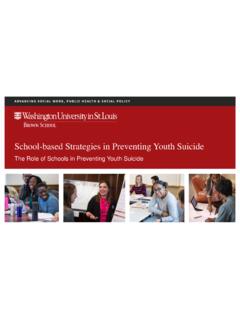Transcription of Planning, Implementing, and Evaluating an …
1 3822 GPO Page 178:31 AM 7/26/02 Chapter One planning , implementing , and Evaluating an Intervention An Ov erview 3822 GPO Page 198:31 AM 7/26/02 Chapter 1 - 5 planning , implementing , and Evaluating an Intervention An Overview Introduction planning , implementing , and Evaluating an intervention can be a daunting project, especially for someone who has never been involved in such an effort. However, you can improve your chances of success if you follow certain steps. This chapter gives a brief overview of those steps. In this chapter, we will explain how and why to do the following.
2 Describe the problem of youth violence in your community Identify intended participants for an intervention Identify possible settings in which to reach intended participants Set goals and objectives Select an intervention or multiple interventions that will most appropriately address your goals and objectives and meet the needs of your participants Locate resources for your intervention Involve the community in your effort Develop activities and materials for your intervention Hire and train staff Monitor your intervention s progress Evaluate the success of your intervention If after reading this chapter, you have questions or concerns about developing an intervention for your community, take a look at the Additional Resources section at the end of the chapter.
3 The publications listed there contain helpful information about such topics as assessing a community s resources and readiness to change, working with diverse populations, and Evaluating a program. Definitions You will see the terms strategy, intervention, and program repeated many times throughout this sourcebook. Because these terms may mean slightly different things to people in different professions, we have defined them here so all readers will know how they are used in this publication. Strategy: A general conceptual approach to preventing violence by children and adolescents.
4 For example, home visiting can offer basic training in parenting skills for pregnant teens. 3822 GPO Page 208:31 AM 7/26/02 6 - Chapter 1 Intervention: A specific set of activities and accompanying materials developed to prevent youth violence and the factors that contribute to it. For example, a school may implement a curriculum and role-playing activities to help students develop conflict-resolution skills. Program: A grouping of strategies (and, therefore, of various kinds of interventions) designed to prevent youth violence. For example, a community might combine a school-based curriculum with a home-visiting intervention.
5 Describe the Problem Before you can plan an intervention to prevent violence committed by children and adolescents in your community, you need an accurate description of the problem. This description will help you identify who is affected most by the problem and where the problem occurs most frequently so you can better target an intervention. It will guide you in developing realistic objectives for your intervention and will provide a baseline against which to measure progress. You also need a clear definition of the problem to convince lawmakers, community leaders, parents, volunteers, and potential funders that your intervention is necessary.
6 The information you need to describe the problem can be obtained from several sources. Quantitative data is available from a number of agencies and organizations that collect statistics on youth violence, and you can interview or survey members of your community to get qualitative information ( , opinions, attitudes). Regardless of where you get your information, be sure the individuals collecting it are respected and trusted by the community. Factual information Many sources of data exist to help you define the problem of youth violence in your community. Table 1 lists some of those sources.
7 Appendix A at the end of this sourcebook also provides data about youth violence at a national level. Before asking agencies and organizations for information, do a little research. Table 1 Sources of Factual Information about youth Violence Police records Vital statistics division of state or local health department Medical examiner Hospital or emergency department records Outpatient records from public or private clinics Emergency medical service (ambulance) records School nurse s records, attendance records, and records of disciplinary infractions youth risk behavior surveys (see Additional Resources for details) Federal agencies (see Additional Resources for details)
8 Before you plan an intervention to prevent violence committed by children and adolescents in your community, you need an accurate description of the problem. 3822 GPO Page 218:31 AM 7/26/02 Chapter 1 - 7 Once you know how many young people committed violent acts, when and where the acts took place, and what circumstances surrounded those acts, you may want to find out about factors in your community that could contribute to violence. Find out what information each entity has and limit your request to that information. Don t send out one blanket request to several agencies, hoping to find information you need.
9 Because information about children and adolescents who commit violent acts is often kept confidential, you may have to get summary data. Summary data provide the statistics without any information that could identify the people involved. If you are working with a research organization or university, its staff should know how to get legal access to records. Once you know how many young people committed violent acts, when and where the acts took place, and what circumstances surrounded those acts, you may want to find out about factors in your community that could contribute to violence.
10 Examples of contributing factors include racism, poverty, unemployment, and other social, cultural, or economic conditions. Some of this information can be obtained from the Census (available through your local library), the Department of Labor s employment statistics, and the Department of Housing and Urban Development. Opinions from community members How do members of your community perceive the problem of youth violence, and what do they think is causing it? To find out, survey residents, community leaders, school personnel, legal and police personnel, health workers, and parents.



